Towards Sustainable Rural Development: Assessment Spatio-Temporal Evolution of Rural Ecosystem Health through Integrating Ecosystem Integrity and SDGs
Abstract
:1. Introduction
2. Methods and Data Source
2.1. Integrating SDGs into Rural Ecosystem Health Assessments
2.2. Study Area
2.3. Data Sources
- Spatio-temporal data mainly consist of vector spatial data, land use data, and natural, social and economic statistics. Among them, the administrative division boundaries (1:50,000) and Chongqing Topographic map (1:500,000) mainly rely on the “Chongqing 1:50,000 Topographic Map (2018)” exported by the Geographic Information Center.
- Land use change (LUCC) data were derived from Landsat TM/ETM/OLI remote sensing images. According to the existing land use/land cover classification system, land use types were divided into six primary and 25 secondary categories.
- The socio-economic and environmental data mainly come from the Chongqing Statistical Yearbook (2000–2018), the Chongqing Annual Report of Environmental Statistics (2000–2018), the Third National Agricultural Census in 2016 (Chongqing), the Three-Five-Year Plan, Chongqing Municipal People’s Government website, Chongqing Agricultural Commission website, etc. SPSS21 and ArcGIS 10.2 were used for data preprocessing, analysis, and visual presentation.
2.4. Rural Ecosystem Health Evaluation Indicator System
2.4.1. Rural Resources Subsystem Health (RRS)
2.4.2. Rural Agricultural Subsystem Health (RAS)
2.4.3. Rural Environmental Subsystem Health (REnvS)
2.4.4. Rural Socioeconomic Subsystem Health (RSecS)
2.5. Determination of Indicator Weights and Rural Ecosystem Health Evaluation Models
2.5.1. Standardizing the Initial Indicators
2.5.2. Calculating Entropy Value of Indicators Using Entropy Weight Method
2.5.3. Calculating the REH Comprehensive Level
2.6. Identification of the Rural Ecosystem Health Spatial Types
- (1)
- When the number of dominant elements is n ≥ 3 (n ≤ 4) (CRij > 0), the REH type is defined as a comprehensive health type. This classification indicates that there are at least three sub-systems involved in the ecosystem health assessment of District I, encompassing five distinct types of comprehensive health categories.
- (2)
- When the number of dominant elements is n = 2 (n ≤ 4) (CRij > 0), the REH is defined as the compound health type. This indicates that there are two sub-systems in the ecosystem health assessment of district i, encompassing six distinct types of compound health classifications.
- (3)
- When the number of dominant elements is n = 1 (n ≤ 4) (CRij > 0), the REH type is defined as a single health type. This classification indicates that a sub-system exists associated with the dominant element in the ecosystem health assessment of district i. Based on the types of dominant elements, four categories can be identified: resource single health type, environment single health type, agriculture single health type, and socioeconomic single health type.
3. Results
3.1. Weights of the REH Indicators System in Chongqing
3.2. The Temporal Evolution of the Comprehensive Scores of the REH in Chongqing from 2000 to 2018
3.3. Spatial Differentiation of the Comprehensive Scores of the REH in 36 Districts and Counties in Chongqing
3.4. Identification of the REH Types in Chongqing
4. Discussion
4.1. The Driving Factors of Affecting REH
4.1.1. Urbanization and REH
4.1.2. Development Strategy, Environment Regulation and REH
4.1.3. Urban-Rural Mobility Factors and REH
4.1.4. Rural Regional Difference and REH
4.2. Differentiation Recommendations and Policies for REH in Choingqing
5. Conclusions and Discussion
Author Contributions
Funding
Data Availability Statement
Conflicts of Interest
References
- Long, H.L.; Jian, Z.; Liu, Y.S. Differentiation of rural development driven by industrialization and urbanization in eastern coastal China. Habitat Int. 2009, 33, 454–462. [Google Scholar] [CrossRef]
- Meng, L.G.; Huang, J.; Dong, J.H. Assessment of rural ecosystem health and type classification in Jiangsu province, China. Sci. Total Environ. 2018, 615, 1218–1228. [Google Scholar] [CrossRef] [PubMed]
- Vitousek, P.M.; Mooney, H.A.; Lubchenco, J. Human domination of Earth’s ecosystems. Science 1997, 277, 494–499. [Google Scholar] [CrossRef]
- Liu, Z.; Guan, D.; Wei, W.; Davis, S.J.; Ciais, P.; Bai, J.; Peng, S.; Zhang, Q.; Hubacek, K.; Marland, G.; et al. Reduced carbon emission estimates from fossil fuel combustion and cement production in China. Nature 2015, 524, 335–338. [Google Scholar] [CrossRef]
- Yang, C.; Zeng, W.; Yang, X. Coupling coordination evaluation and sustainable development pattern of geo-ecological environment and urbanization in Chongqing municipality, China. Sustain. Cities Soc. 2020, 61, 102271–102283. [Google Scholar] [CrossRef]
- Wu, M.W.; Wu, J.Q.; Zang, C.F. A comprehensive evaluation of the eco-carrying capacity and green economy in the Guangdong-Hong Kong-Macao Greater Bay Area, China. J. Clean. Prod. 2021, 281, 124945–124968. [Google Scholar] [CrossRef]
- Li, Q.; Li, W.Y.; Zhao, Y.; Zhu, Y.E.; Chen, Z.F.; Qiao, J.J. Exploration on the basic connotation and evaluation system of rural ecosystem health. Ecol. Environ. Sci. 2009, 18, 1604–1608. [Google Scholar]
- Xu, W.; Julius, A.M. A review of concepts and criteria for assessing agroecosystem health including a preliminary case study of southern Ontario. Agric. Ecosyst. Environ. 2001, 83, 215–233. [Google Scholar] [CrossRef]
- Long, H.L. Land consolidation and rural spatial restructurin. Acta Geogr. Sin. 2013, 68, 1019–1028. (In Chinese) [Google Scholar]
- Peng, J.; Liu, Y.X.; Li, T.Y.; Wu, J.S. Regional ecosystem health response to rural land use change: A case study in Lijiang City, China. Ecol. Indic. 2017, 72, 399–410. [Google Scholar] [CrossRef]
- Neri, A.C.; Dupin, P.; Sanchez, L.E. A pressure-state-response approach to cumulative impact assessment. J. Clean. Prod. 2016, 126, 288–298. [Google Scholar] [CrossRef]
- Styers, D.M.; Chappelka, A.H.; Marzen, L.; Somerrs, G.L. Developing a land-cover classification to select indicators of forest ecosystem health in a rapidly urbanizing landscape. Landsc. Urban Plan. 2010, 94, 158–165. [Google Scholar] [CrossRef]
- Lepold, J.C. Getting a handle on ecosystem health. Science 1997, 276, 887–901. [Google Scholar]
- Rapport, D.J. What constitute ecosystem health? Perspect. Biol. Med. 1989, 33, 120–132. [Google Scholar] [CrossRef]
- Lackey, R.T. Values, policy, and ecosystem health. Bioscience 2001, 51, 437–443. [Google Scholar] [CrossRef]
- Shrader-Frechette, K.S. Ecosystem health: A new paradigm for ecological assessment? Trends Ecol. Evol. 1994, 9, 456–457. [Google Scholar] [CrossRef]
- Shear, H. The development and use of indicators to assess the state of ecosystem health in the Great Lakes. Ecosyst. Health 1996, 2, 241–258. [Google Scholar]
- Ma, S.J.; Wang, R.S. The social-economic-natural complex ecosystem. Acta Ecol. Sinca 1984, 4, 1–9. (In Chinese) [Google Scholar]
- Apport, D.J.; Costanza, R.; Mcmichael, A.J. Assessing eco-system health. Trends Ecol. Evol. 1998, 13, 397–402. [Google Scholar] [CrossRef]
- Qi, F.; Li, Q.X.; Zhu, L. Assessment method of marine ecosystem health. Mar. Sci. Bull. 2007, 26, 97–104. [Google Scholar]
- Zhao, Z.Y.; Xu, F.L.; Zhan, W.; Hao, J.Y.; Zhang, Y.; Zhao, S.S.; Hu, W.P.; Tao, S. A quantitative method for assessing lake ecosystem health. Acta Ecol. Sin. 2005, 25, 1466–1474. (In Chinese) [Google Scholar]
- Pinto, U.; Maheshwari, B.L.; Ollerton, R.L. Analysis of long-term water quality for effective river health monitoring in peri-urban landscapes—a case study of the Hawkesbury—Nepean river system in NSW, Australia. Environ. Monit. Assess. 2013, 185, 4551–4569. [Google Scholar] [CrossRef] [PubMed]
- Shen, C.C.; Shi, H.H.; Zheng, W.; Ding, D.W. Spatial heterogeneity of ecosystem health and its sensitivity to pressure in the waters of nearshore archipelago. Ecol. Indic. 2016, 61, 822–832. [Google Scholar] [CrossRef]
- Zhang, Y.; Yang, Z.F.; Yu, X.Y. Measurement and evaluation of interactions in complex urban ecosystem. Ecol. Model. 2006, 196, 77–89. [Google Scholar] [CrossRef]
- Chaves, H.M.L.; Alipaz, S. An integrated indicator based on basin hydrology, environment, life, and policy: The watershed sustainability index. Water Resour. Manag. 2007, 21, 883–895. [Google Scholar] [CrossRef]
- Mageau, M.T.; Costanza, R.; Ulanowicz, R.E. The development and initial testing of a quantitative assessment of ecosystem health. Ecosyst. Health 1995, 1, 201–213. [Google Scholar]
- Zhang, J.E.; Luo, S.M. A discussion on basic content and evaluation index system of agroecosystem health. Chin. J. Appl. Ecol. 2004, 15, 1473–1476. (In Chinese) [Google Scholar]
- Van, N.L.; Adams, J.B.; Bate, G.C.; Forbes, A.T.; Forbess, N.T.; Huizinga, P.; Lamberth, S.J.; Mackay, C.F.; Petersen, C.; Talijaard, S.; et al. Country-wide assessment of estuary health: An approach for integrating pressures and ecosystem response in a data limited environment. Estuar. Coast. Shelf Sci. 2013, 130, 239–251. [Google Scholar]
- Bebianno, M.J.; Pereira, C.G.; Rey, F.; Cravo, A.; Duarte, D.; D’Errico, G.; Regoli, F. Integrated approach to assess ecosystem health in harbor areas. Sci. Total Environ. 2015, 514, 92–107. [Google Scholar] [CrossRef]
- Sun, C.; Wu, Y.; Zou, W.; Zhao, L.; Liu, W. A Rural Water Poverty Analysis in China Using the DPSIR-PLS Model. Water Resour. Manag. 2018, 32, 1933–1951. [Google Scholar] [CrossRef]
- Wang, F.; Zhang, R.; Kang, P.; Zhao, H. An evaluation of the ecological security of the Dongting lake, China. Desalination Water Treat. 2018, 110, 283–297. [Google Scholar] [CrossRef]
- Zhao, R.; Shao, C.; He, R. Spatiotemporal Evolution of Ecosystem Health of China’s Provinces Based on SDGs. Int. J. Environ. Res. Public Health 2021, 18, 10569. [Google Scholar] [CrossRef] [PubMed]
- Pan, Z.; He, J.; Liu, D.; Wang, J.; Guo, X. Ecosystem health assessment based on ecological integrity and ecosystem services demand in the middle reaches of the yangtze river economic belt, China. Sci. Total Environ. 2021, 774, 144837. [Google Scholar] [CrossRef]
- Ostrom, E. A general framework for analyzing sustainability of social-ecological systems. Science 2009, 325, 419–422. [Google Scholar] [CrossRef]
- Liu, J.; Dietz, T.; Carpenter, S.R.; Alberti, M.; Folke, C.; Moran, E.; Pell, A.N.; Deadman, P.; Kratz, T.; Lubchenco, J.; et al. Complexity of coupled human and natural systems. Science 2007, 317, 1513–1516. [Google Scholar] [CrossRef]
- Shen, W.; Zheng, Z.; Qin, Y.; Li, Y. Spatiotemporal characteristics and driving force of ecosystem health in an important ecolog-ical function region in China. Int. J. Environ. Res. Public Health 2020, 17, 5075. [Google Scholar] [CrossRef]
- Costanza, R. Ecosystem health and ecological engineering. Ecol. Eng. 2012, 45, 24–29. [Google Scholar] [CrossRef]
- Li, W.; Wang, Y.; Xie, S.; Cheng, X. Coupling coordination analysis and spatiotemporal heterogeneity between urbanization and ecosystem health in Chongqing municipality, China. Sci. Total Environ. 2021, 791, 148311. [Google Scholar] [CrossRef]
- Liu, Y.; Yang, C.; Tan, S.; Zhou, H.; Zeng, W. An approach to assess spatio-temporal heterogeneity of rural ecosystem health: A case study in Chongqing mountainous area, China. Ecol. Indic. 2022, 136, 108644. [Google Scholar] [CrossRef]
- Lu, Y.; Wang, R.; Zhang, Y.; Su, H.; Wang, P.; Jenkins, A.; Ferrier, R.C.; Bailey, M.; Squire, G. Ecosystem health towardssustainability. Ecosyst. Health Sustain. 2015, 1, 1–15. [Google Scholar]
- Hu, M.; Sarwar, S.; Li, Z. Spatio-Temporal Differentiation Mode and Threshold Effect of Yangtze River Delta Urban Ecological Well-Being Performance Based on Network DEA. Sustainability 2021, 13, 4550. [Google Scholar] [CrossRef]
- Ji, Y.; Huang, G.H.; Sun, W. Risk assessment of hydropower stations through an integrated fuzzy entropy-weight multiple criteria decision making method: A case study of the Xiangxi River. Expert Syst. Appl. 2015, 42, 5380–5389. [Google Scholar] [CrossRef]
- Shemshadi, A.; Shirazi, H.; Toreihi, M.; Tarokh, M.J. A fuzzy VIKOR method for supplier selection based on entropy measure for objective weighting. Expert Syst. Appl. 2011, 38, 12160–12167. [Google Scholar] [CrossRef]
- Wang, C.; He, Y.Z. Spatio-temporal differentiation and differentiated regulation of the vulnerability of rural production space system in Chongqing. Acta Geogr. Sin. 2020, 75, 1680–1698. (In Chinese) [Google Scholar]
- Li, P.X.; Chen, W.; Sun, W. Spatial differentiation and influencing factors of rural territorial multifunctions in developed regions: A case study of Jiangsu Province. Acta Geogr. Sin. 2014, 69, 797–807. [Google Scholar]
- Wang, X.; Yang, C.; Liu, T.; Chen, G.; Yue, H. Assessment spatio-temporal coupling coordination relationship between mountain rural ecosystem health and urbanization in Chongqing municipality, China. Environ. Sci. Pollut. Res. 2022, 29, 48388–48410. [Google Scholar] [CrossRef]
- Bryan, B.A.; Gao, L.; Ye, Y.; Sun, X.; Connor, J.D.; Crossman, N.D.; Stafford-Smith, M.; Wu, J.; He, C.; Yu, D.; et al. China’s response to a national land-system sustainability emergency. Nature 2018, 559, 193–204. [Google Scholar] [CrossRef]
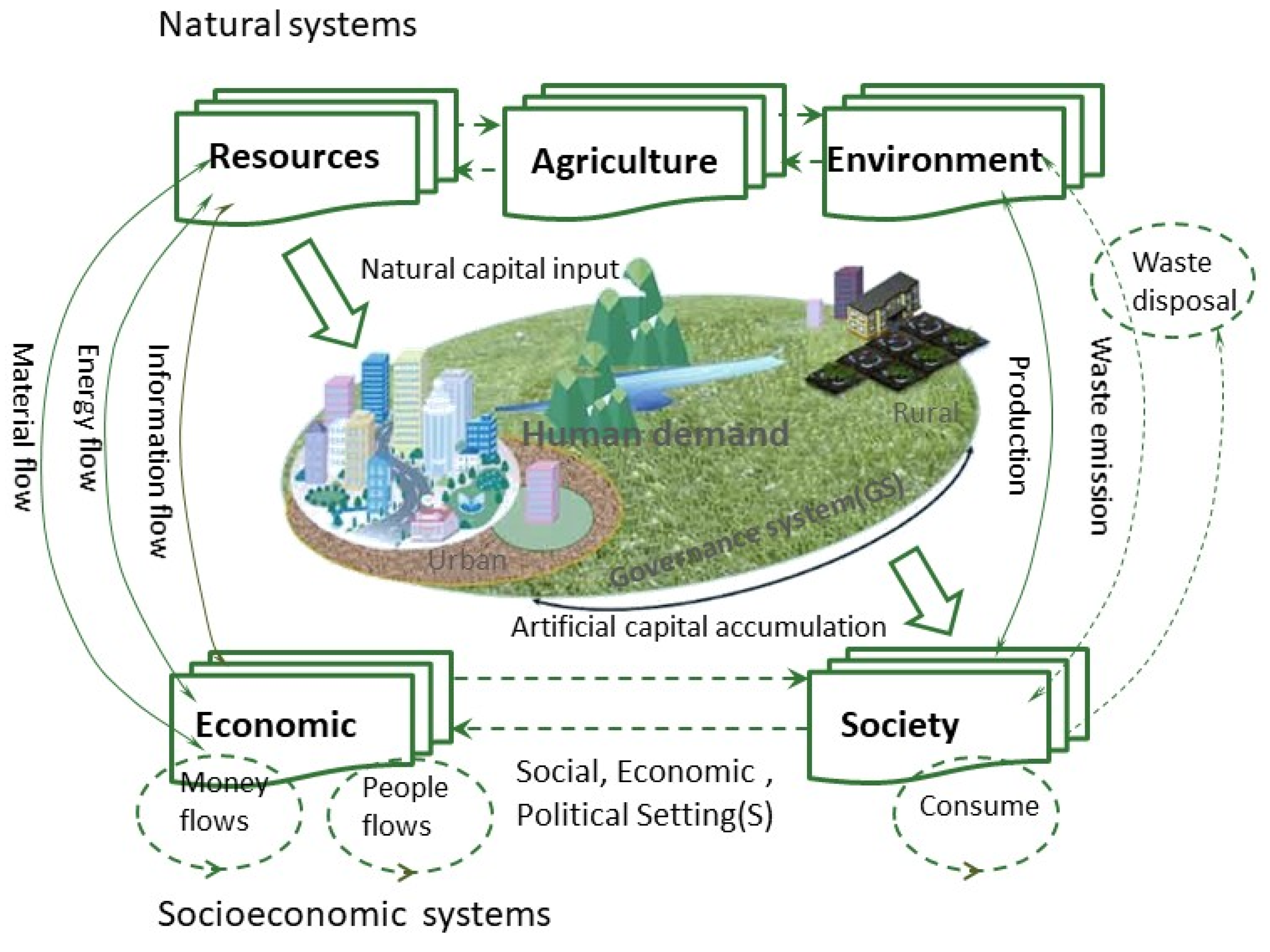

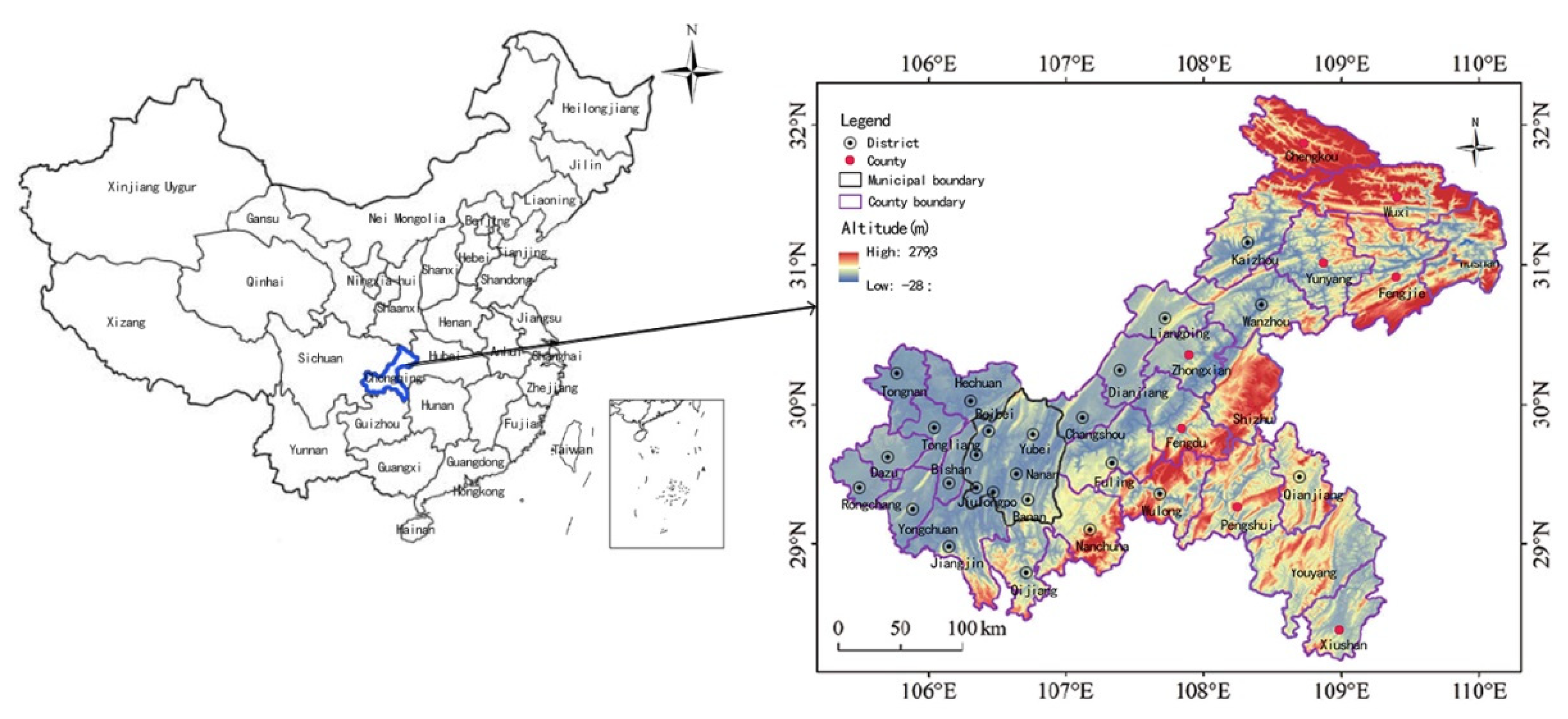
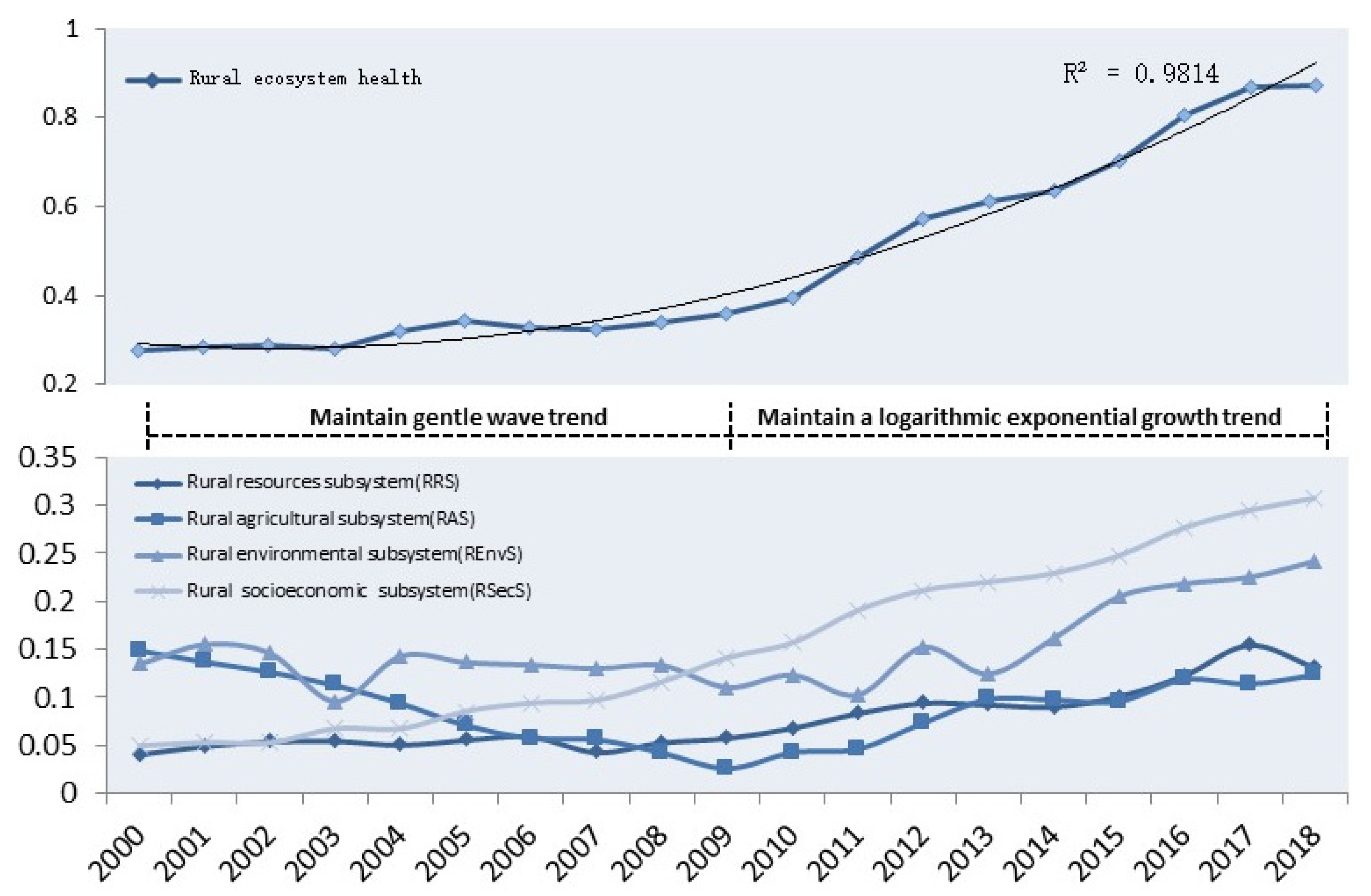
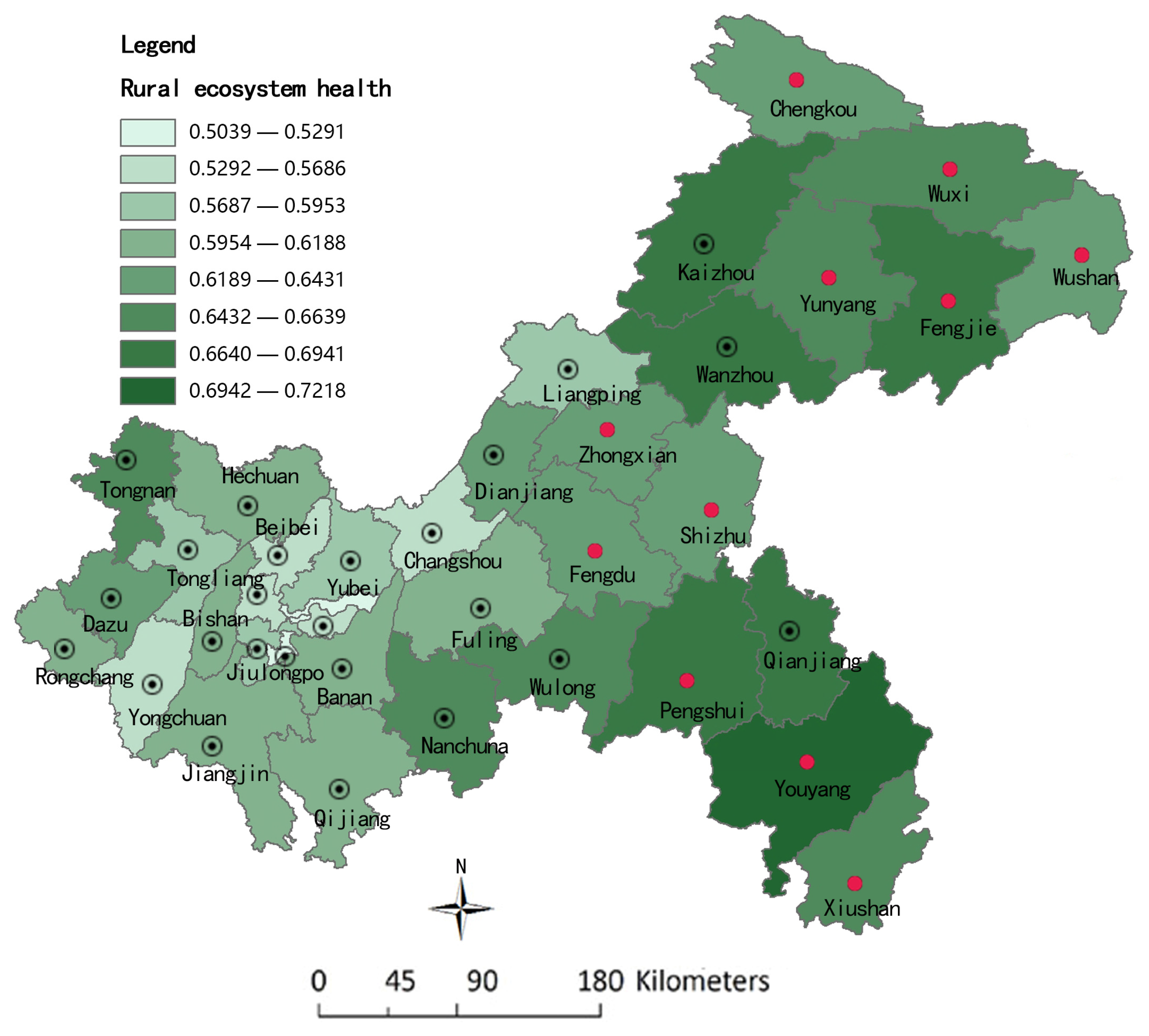
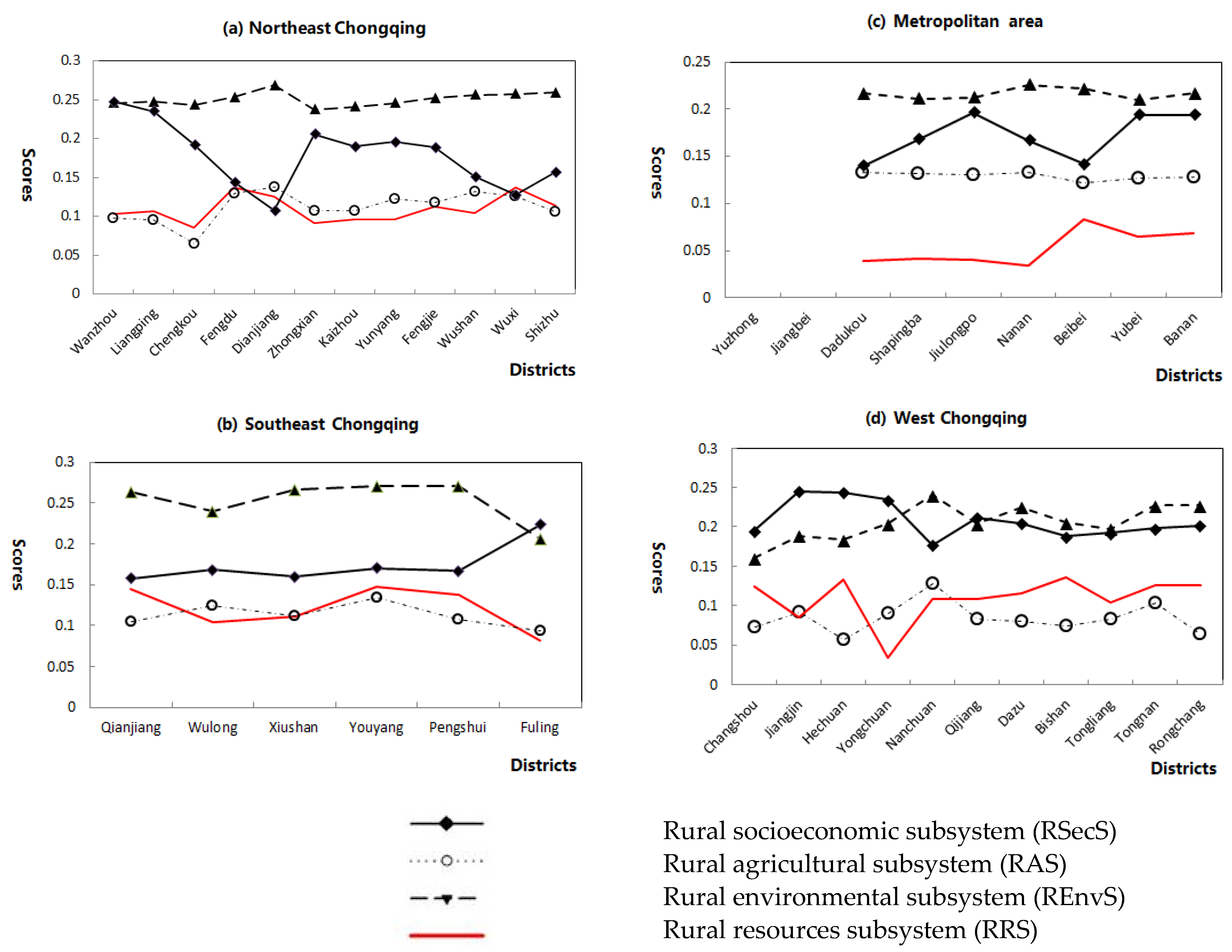
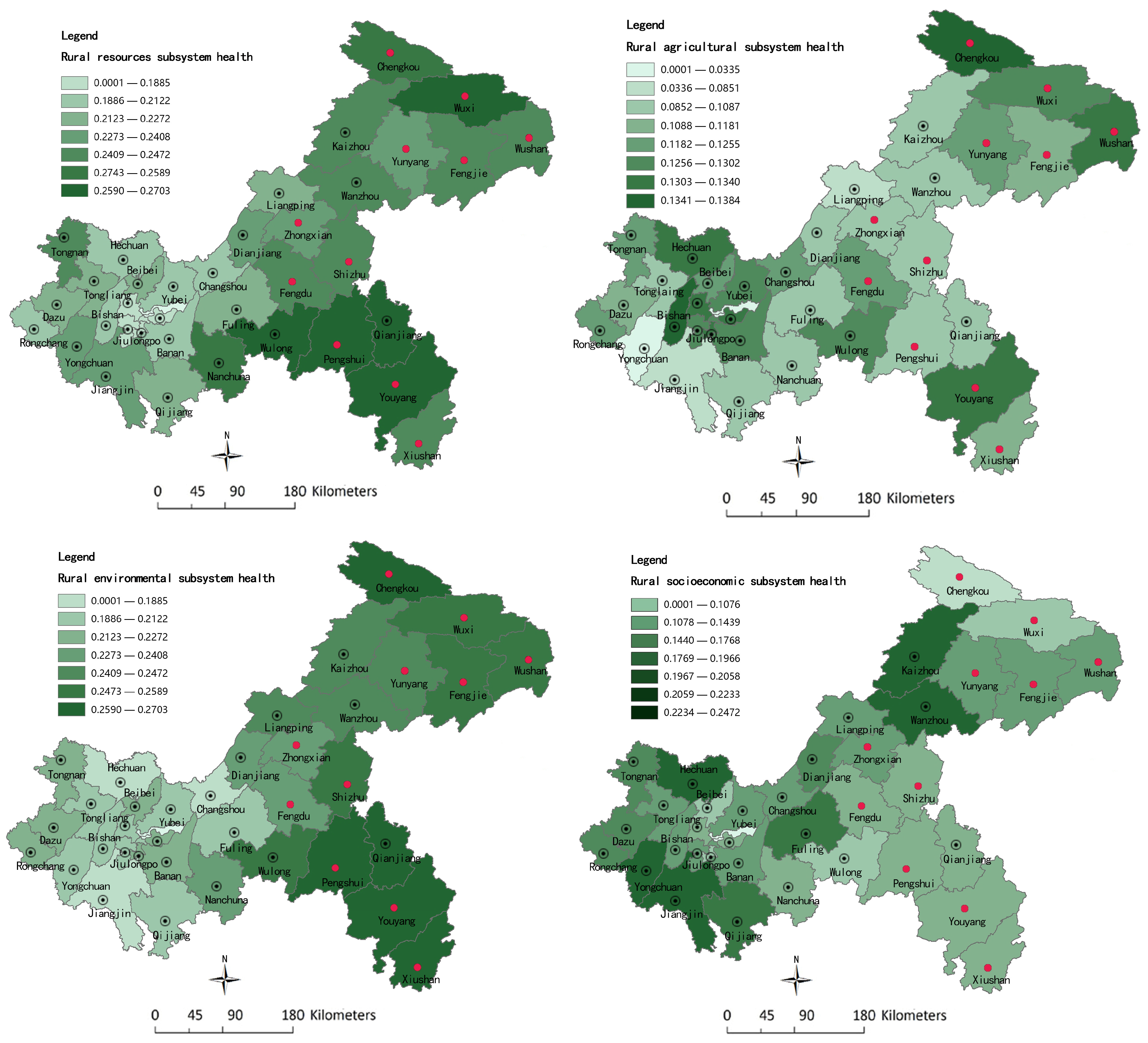
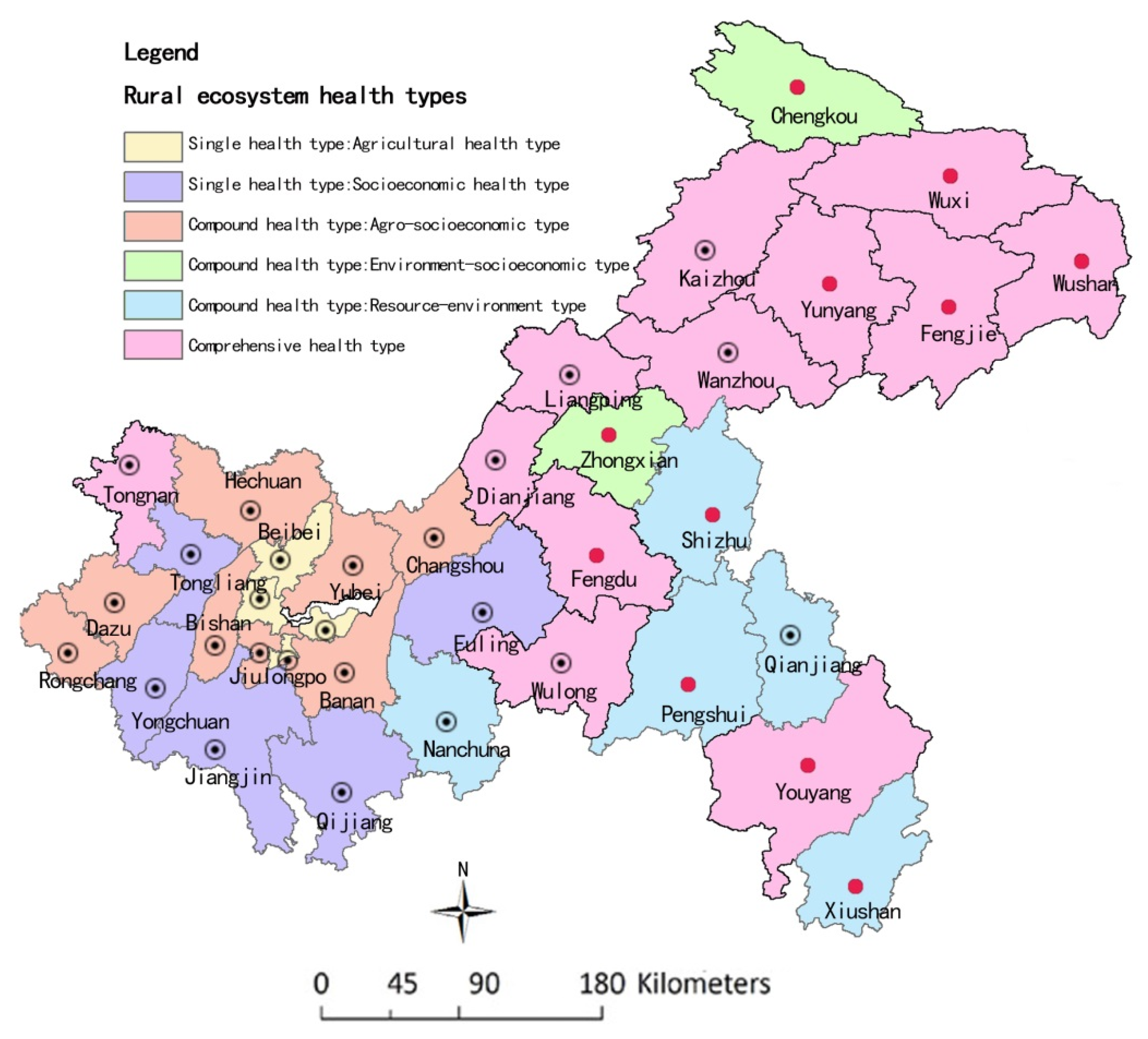
| System | Subsystem | No. | Indicators | Connotation | Units | 2018 Value | Indicator Character | Benchmark |
|---|---|---|---|---|---|---|---|---|
| Rural Ecosystem health (R) | Rural resources subsystem (RES) | R11 | Cultivated land area per capita | Total cultivated area/rual total population | ha | 0.7 | Positive | SDG6 SDG13 SDG15 |
| R12 | Water resources per capita | Total water resources/rural total population | m3/per capita | 225.59 | Positive | |||
| R13 | Irrigated area per capita | Irrigated area is equal to the sum area of paddy field and irrigated land that could be normally irrigated with irrigation equipment, reflecting the suitable tillage condition of cultivated land/rual total population | ha | 0.32 | Positive | |||
| R14 | Forest coverage rate | Forest coverage rate reflects the richness of forest resources and the status of ecological balance | % | 48.3 | Positive | |||
| rural agricultural subsystem (RAS) | R21 | Sown area of farm corps per capita | Sown area of farm crops refers to agricultural production operators sown or transplant area on all the land (arable or non-arable land) in the calendar year, reflecting the rural crop production situation/rual total population | ha | 0.16 | Positive | SDG2 SDG15 | |
| R22 | Chemical fertilizer use intensity | Fertilizer application rate/cultivated area | Ton/km2 | 3.91 | Negative | |||
| R23 | Chemical pesticides use intensity | Pesticide application rate/cultivated area | Ton/km2 | 0.72 | Negativ | |||
| R24 | The grain output per capita | The grain output refers to the total amount of grain produced by agricultural producers and operators during the calendar year/rual total population | Ton | 5.16 | Positive | |||
| rural environmental subsystem (REnvS) | R31 | The rate of water quality up to the standard | Percentage of drinking water sources up to standard | % | 100 | Positive | ||
| R32 | Proportion of high quality days | High air quality days/per year | % | 86.6 | Positive | SDG6 SDG13 SDG15 | ||
| R33 | Biological richness index ① | Biological richness index is obtained by calculating the three indicators of plant richness, proportion of area of nature reserve and wildlife richness | % | 71.32 | Positive | |||
| R34 | Acid rain frequency | Number of acid rain days/per year | % | 14 | Negativ | |||
| R35 | Comprehensive energy consumption | Total energy consumption/GDP | Ton standard coal/ten thousand yuan | 0.422 | Negativ | |||
| R36 | Crop disaster area per year ② | The area of crops lost | km2 | 70.86 | Negativ | |||
| Rural socioeconomic subsystem (RSecS) | R41 | The per capita output value of agriculture, forestry, animal husbandry and fishery | Gross output value of agriculture, forestry, animal husbandry and fishery/rural total population | ten thousand yuan/Person | 1.1742 | Positive | SDG1 SDG2 SDG3 SDG4 SDG5 SDG7 SDG8 SDG9 SDG12 | |
| R42 | Density of rural population | Rural population/total area | Person/km2 | 212.12 | Positive | |||
| R43 | Per capita self-owned housing area in rural | Rural residential area/rural resident population | m2 | 53.93 | Positive | |||
| R44 | Per capita rural electricity consumption | Rural electricity consumption/rural population | kw·h/person | 454.98 | Positive | |||
| R47 | Per capita living expenditure of rural residents | Per capita living expenditure of rural residents reflects the average income level of rural residents according to the average net income level of the population, | Yuan | 13,781 | Positive | |||
| R46 | Rural employment population | Rural personnel engaged in social labor for the purpose of obtaining remuneration or income from business operations | Peopel | 1285.41 | Positive | |||
| R47 | General public budgetary expenditure | Government expenditures for the provision of basic public administration and services | Yuan | 45,409.49 × 105 | Positive | |||
| R48 | Engel coefficient of rural residents | Rural residents total expenditure on food, tobacco and alcohol/total expenditure on consumption | % | 34.9 | Negativ |
Disclaimer/Publisher’s Note: The statements, opinions and data contained in all publications are solely those of the individual author(s) and contributor(s) and not of MDPI and/or the editor(s). MDPI and/or the editor(s) disclaim responsibility for any injury to people or property resulting from any ideas, methods, instructions or products referred to in the content. |
© 2024 by the authors. Licensee MDPI, Basel, Switzerland. This article is an open access article distributed under the terms and conditions of the Creative Commons Attribution (CC BY) license (https://creativecommons.org/licenses/by/4.0/).
Share and Cite
Yang, C.; Tan, S.; Zhou, H.; Zeng, W. Towards Sustainable Rural Development: Assessment Spatio-Temporal Evolution of Rural Ecosystem Health through Integrating Ecosystem Integrity and SDGs. Land 2024, 13, 1672. https://doi.org/10.3390/land13101672
Yang C, Tan S, Zhou H, Zeng W. Towards Sustainable Rural Development: Assessment Spatio-Temporal Evolution of Rural Ecosystem Health through Integrating Ecosystem Integrity and SDGs. Land. 2024; 13(10):1672. https://doi.org/10.3390/land13101672
Chicago/Turabian StyleYang, Chun, Shaohua Tan, Hantao Zhou, and Wei Zeng. 2024. "Towards Sustainable Rural Development: Assessment Spatio-Temporal Evolution of Rural Ecosystem Health through Integrating Ecosystem Integrity and SDGs" Land 13, no. 10: 1672. https://doi.org/10.3390/land13101672
APA StyleYang, C., Tan, S., Zhou, H., & Zeng, W. (2024). Towards Sustainable Rural Development: Assessment Spatio-Temporal Evolution of Rural Ecosystem Health through Integrating Ecosystem Integrity and SDGs. Land, 13(10), 1672. https://doi.org/10.3390/land13101672





